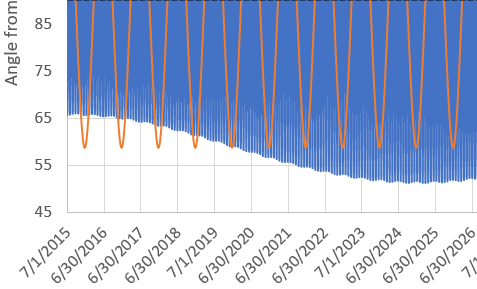
Berkeley’s Solar Calendar
was founded by Santiago Casals as a tribute to César Chávez & Dolores Huerta (solarcalendar.org)
- Hope (East)
- Determination (South)
- Courage (West)
- Tolerance (North)
Frequently Asked Questions (FAQ):
1. What do “solstice” and “equinox” mean?
2. Where is the sunset on the equinoxes, solstices, and at various times of year?
(Solar Motion Demonstrator)
3. When is the exact time of solstice/equinox? When does the Sun set?
4. What happens at noon at the Solar Calendar?
5. What celebrations happen around the times of solstices and equinoxes?
6. Is the winter solstice the day of latest sunrise and earliest sunset?
7. What causes the seasons?
8. What is a sundial?
9. Do moonrises and moonsets behave the same as sunrises and sunsets?
1. What do “solstice” and “equinox” mean?
In simplest terms, the two equinoxes (spring/vernal and fall/autumnal) are the two days of the year when duration of daylight equals that of night. The winter solstice is when the number of hours of daylight is a minimum for the year, while the summer solstice is when the number of hours of daylight is maximum. Winter solstice is also when the sunrise and sunset points are farthest south (northern hemisphere) and the noontime Sun is lowest in the sky for the year; conversely summer solstice is when the sunrise and sunset points are farthest north (northern hemisphere) and the noontime Sun is highest in the sky for the year. Solar Motion Demonstrator is a great model for these concepts.
The word “solstice” comes from the Latin words “sol” (sun) and “stit” (stationary). The elevation angle of the Sun at solar noon as well as the sunset and sunrise horizon positions do not change much from day to day around the solstice times. By contrast, equinoxes are the times of maximum rate of change of sunset and sunrise horizon positions as well as positions of the Sun at solar noon and number of hours of daylight.
2. Where does the Sun set on the equinoxes, solstices, and at various times of year?
Try making and playing with a Solar Motion Demonstrator, a model of Sun-Earth relationships:
- 12 page version (with questions, for classrooms)
- 1 page version (larger size)
- Jumbo demo size (assemble from 3 pages)
The original Solar Motion Demonstrator was developed by Joe Snyder at Oberlin College and is available through the Astronomical Society of the Pacific store.
Here are the sunset positions as seem from the Berkeley Chavez/Huerta Solar Calendar:

3. When is the exact time of solstice/equinox? When Does the Sun set?
2025:
- Spring/Vernal Equinox: Thursday, March 20, 2:01pm PDT (sunset at 7:20pm)
- Summer Solstice: Friday, June 20, 7:42pm PDT (sunset at 8:35pm)
- Fall/Autumnal Equinox: Monday, September 22, 11:19am PDT (sunset at 7pm)
- Winter Solstice: Sunday, December 21, 7:03am PST (sunset at 4:50pm)
4. What happens at noon at the Solar Calendar?
At solar noon, the gnomon stone near the center of the calendar circle casts a shadow due north. That shadow is longest on the winter solstice and shortest on the summer solstice. Here are the solar noons:
- Spring/Vernal Equinox: Thursday, March 20th, 12:50pm PDT
- Summer Solstice: Friday, June 20, 1:10pm PDT
- Fall/Autumnal Equinox: Monday, September 22, 1:01pm PDT
- Winter Solstice: Sunday, December 21, 12:07pm PST
5. What celebrations happen around the times of solstices and equinoxes?
- Winter solstice – See PDF.
- Vernal equinox – See PDF. See also Youtube video about Nowruz
- Summer solstice – Articles: Euro News; Xiazhi – China; Pagan Europe; Sweden; Juhannus – Finland;
- Autumnal equinox – See timeanddate article.
6. Since the winter solstice is the day with least hours of daylight and most hours of night, is the winter solstice the day of latest sunrise and earliest sunset? Similarly for summer solstice?
No. The latest sunrise and earliest sunset of the year do not occur on the winter solstice.
Examples in Berkeley:
For winter solstice:
- 9 hours, 24 minutes of sunlight
- Latest sunrises: 7:25 am, 2025 Jan 3-7 (10 days)
- Earliest sunsets: 4:49 pm, Dec 2-10 (9 days)
For summer solstice:
- 14 hours, 21 minutes of sunlight
- Earliest sunrises: 5:46am, Jun 7 to 19 (12 days)
- Latest sunsets: 8:35pm, Jun 23 to Jul 2 (10 days)
WHY? There are two elements that contribute to unusual variations in timing of sunsets & sunrises:
- tilt of Earth’s axis (23.5°with respect to its orbit) and
- eccentricity of Earth’s orbit (elliptical shape deviates from a perfect circle by 3%)
- the relationship between the two factors is complicated because the direction of Earth’s axis tilt in space is not in the same direction as the closest approach of Earth to the Sun (called perihelion) that occurs on or around January 4 each year, about two weeks AFTER the solstice. The speed of Earth in its orbit varies and is maximum around the time of perihelion. This affects timing of sunrises and sunsets as well as the time of solar noon (the moment when the Sun crosses the north-south meridian line in the sky, when it is highest in the sky on a given day).
Deviations in timings of sunsets are similar to deviations of apparent solar noon from mean solar noon (averaged over the whole year, as displayed in sundials). Deviations are described mathematically as the equation of time. Here is a graph showing the two components of the equation of time (tilt of Earth’s axis and eccentricity of Earth’s orbit):
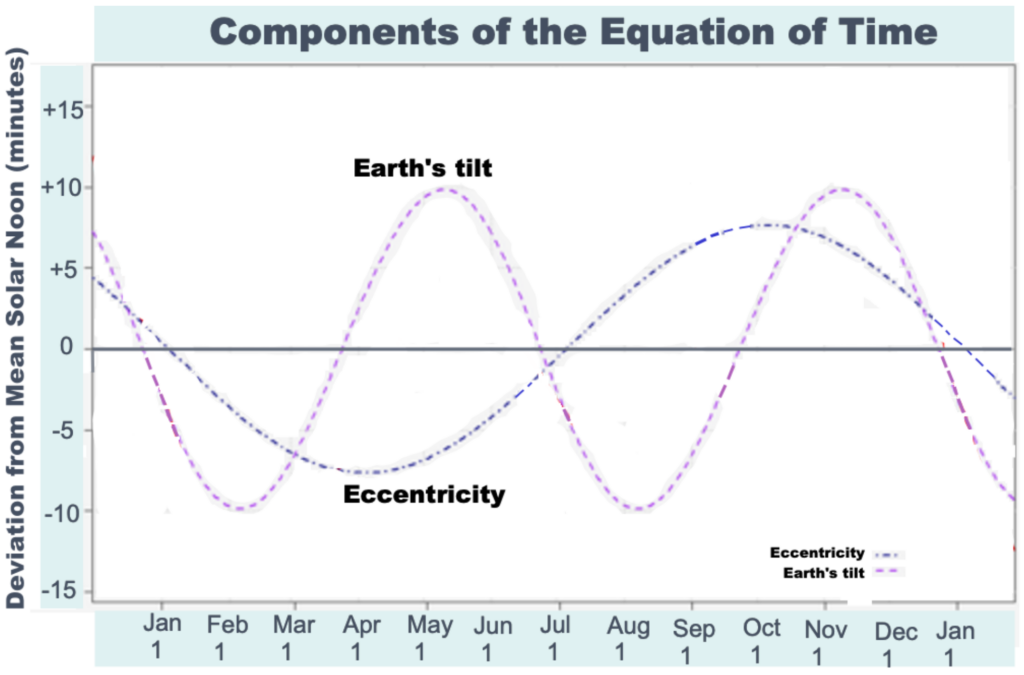
…and here is a graph showing those two components added together to make the equation of time — the red line:
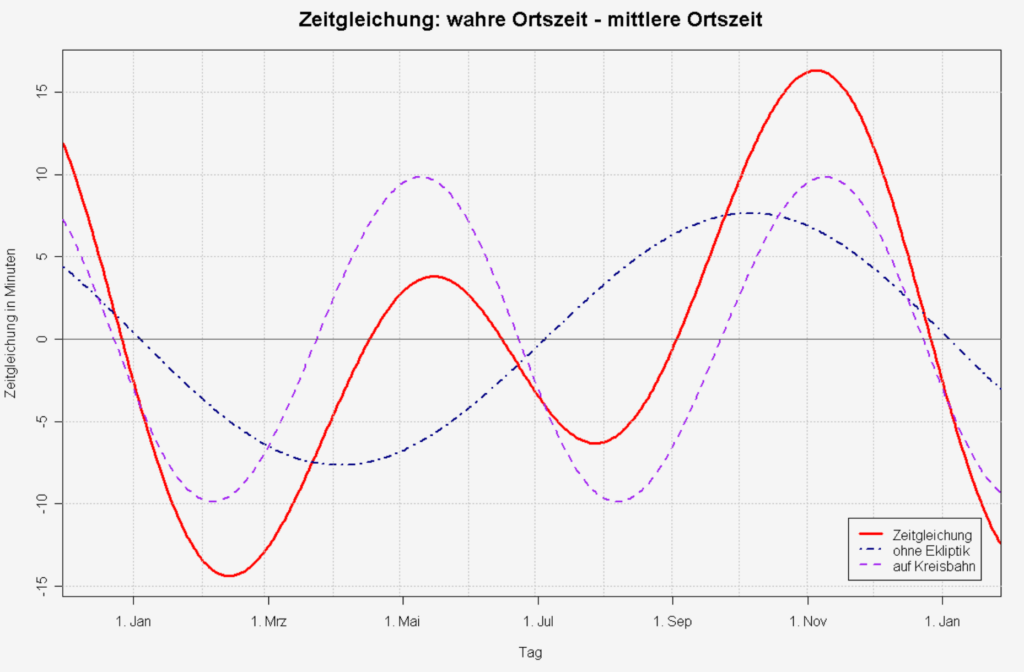
References:
https://in-the-sky.org/article.php?term=equation_of_time
https://en.wikipedia.org/wiki/Equation_of_time
7. What causes the seasons?
Let’s consider some common assumptions:
Assumption 1:
“Seasons are caused by how close the Earth is to the Sun at different times of year.”
In the diagram below, notice that
- for the northern hemisphere Earth is closest to the Sun near the time of the winter solstice (December). The actual time of the closest separation of Earth and Sun is about January 3 each year, an event called perihelion.
- but for the southern hemisphere Earth is closest to the Sun near the time of the summer solstice (that also occurs in December).
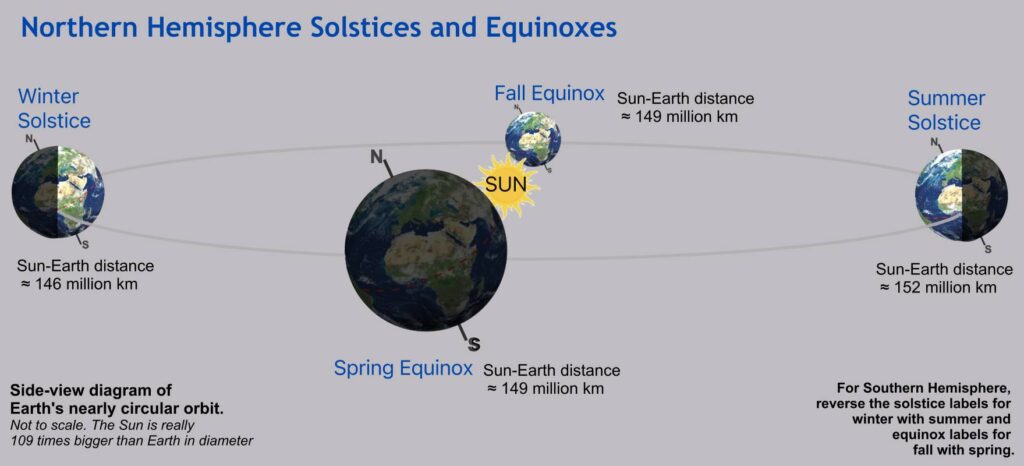
See also: other variations of this seasons diagram (with less text) at the bottom of this page
So for people in the southern hemisphere, changes in the Sun-Earth distance may be a logical explanation for why it’s warmer in summer than in winter. But the logic completely fails for those of us in the northern hemisphere.
That means our assumption that “seasons are caused by how close the Earth is to the Sun at different times of year” must be dead wrong! It’s not even the best reason for the southern hemisphere.
Assumption 2:
“One hemisphere is nearer or farther from the Sun because of the tilt of the Earth. The part that’s tilted toward the Sun is closer to the Sun.”
The diameter of Earth is less than 15,000 km which is negligible compared to the roughly 150 MILLION km Earth-Sun distance. So assumption 2 is also dead wrong.
So what are the real reasons for the seasons?
In the diagram above, Earth’s axis is always pointing towards the North Star, at a 23.5° angle from vertical to the plane of Earth’s orbit. This results in two main effects that cause the seasons:
- variation in number of hours of daylight versus night and
- intensity sunlight depending on the angle of the Sun’s rays striking the ground. The closer to vertical the Sun’s rays are relative to the ground, the more intense the light is.
Example: In the northern hemisphere’s winter,
- less of the northern hemisphere is illuminated by sunlight, resulting in fewer daylight hours and more night hours
- sunlight is less intense due to the more oblique angle of Sun’s rays striking the ground. In this context, oblique means far from perpendicular.
Back to FAQ list
Northern Hemisphere Solstices and Equinoxes — alternate diagrams

The above diagram, with black background, is suitable for planetarium use. Both that diagram and the one below should include a caption or explanation that clarifies and elaborates:
- For southern hemisphere, reverse the solstice and equinox labels.
- This is a side view diagram of Earth’s nearly circular orbit. It is not to scale—the Sun is really over 100 times bigger than Earth in diameter; and the distances are hopelessly too small to reflect the true scale of the orbit.
- The solstice dates are approximately (+or- 1 day) June 21 and December 21; while the equinox dates are approximately March 21 and September 22,
- Incoming solar energy for either hemisphere is greatest at the summer solstice and least at the winter solstice. Incoming solar energy is equal in both northern and southern hemispheres at the equinoxes.
- Because of the 23.5° tilt of Earth’s axis, the Sun can appear directly overhead only for latitudes between the Tropic of Cancer (23.5° N) and the Tropic of Capricorn (23.5° S).
- North of the Arctic Circle (66.5°N) or south of 66.5°S the Sun never rises half the year and never sets in other half of the year.

8. What is a sun dial?
A sundial tells the time of day when in direct sunlight. It does that usually by one part of it, called the gnomon, casting a shadow onto the “dial” part of the sundial that has lines corresponding to times of day. In some sundials, the gnomon is parallel to Earth’s axis of rotation. But there are a myriad of geometries of sundials. For example, a Shepherd’s Sundial has a time dial that is vertical cylinder with the gnomon extending horizontally from it and adjustable for different dates.
9. Do moonrises and moonsets behave the same as sunrises and sunsets?
Yes and no. Moonrises and moonsets go through a cycle of northerly and southerly extremes, but instead of the cycle repeating annually, there is a monthly cycle as shown in the graph below.
The graphs below are from
https://astronomy.stackexchange.com/questions/40613/a-plot-of-the-moon-rise-sets-on-the-horizon-location
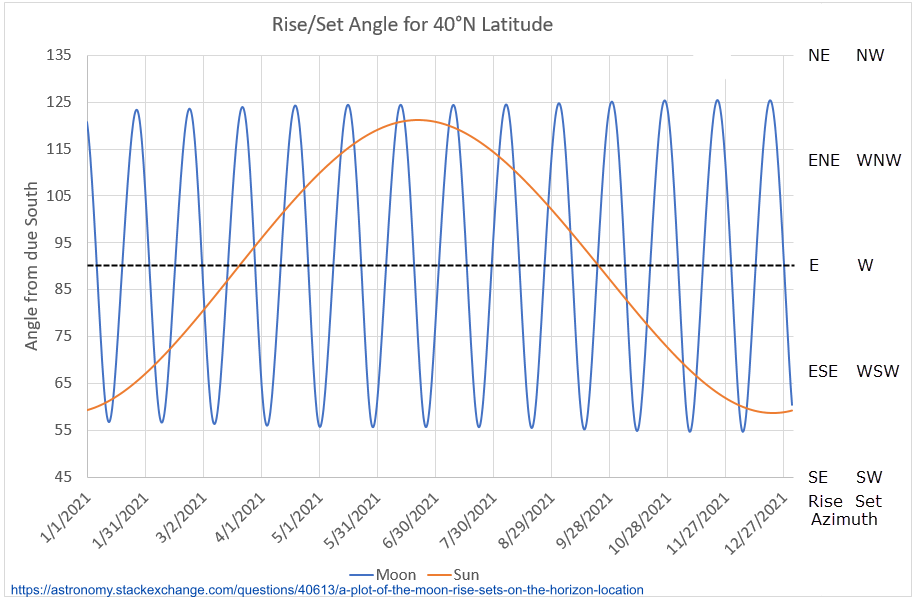
Moonrise & moonset cycles are further complicated by the fact that not only is Earth spin axis tilted by 23.5° with respect to its orbit plane, but the Moon’s orbit is tilted to the Earth’s orbit by 5° to 6°. That results in the cycle of moonrise/moonset horizon postions having extremes that vary slightly from one month to the next. The graph below shows those variations over a cycle that lasts about 18.6 years.
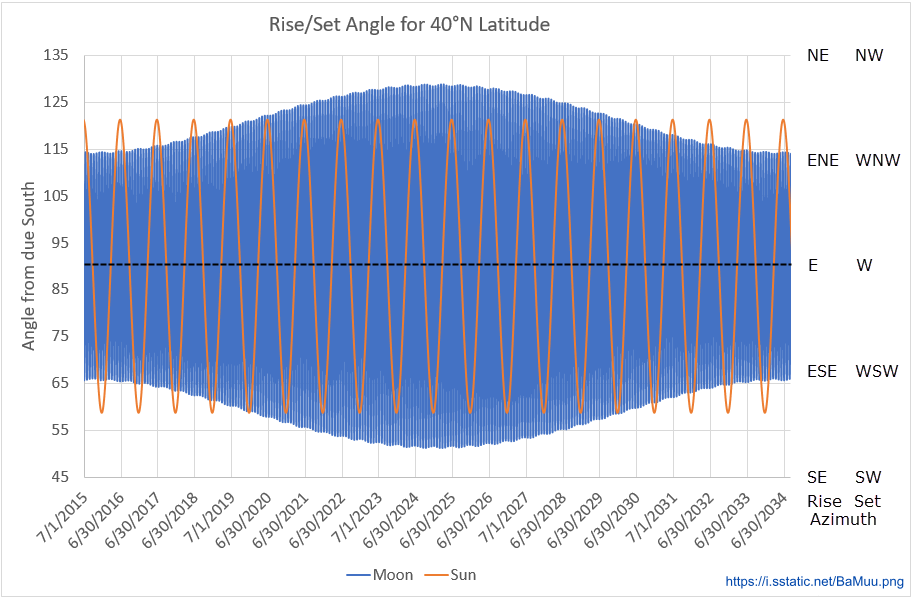
And the graph below is an enlargement of the cycles of southerly extremes from 2015 to 2026. Moonrise/moonset cycles from month to month are rather complicated, but you might see that there was an overall southerly maximum extreme in 2025.
